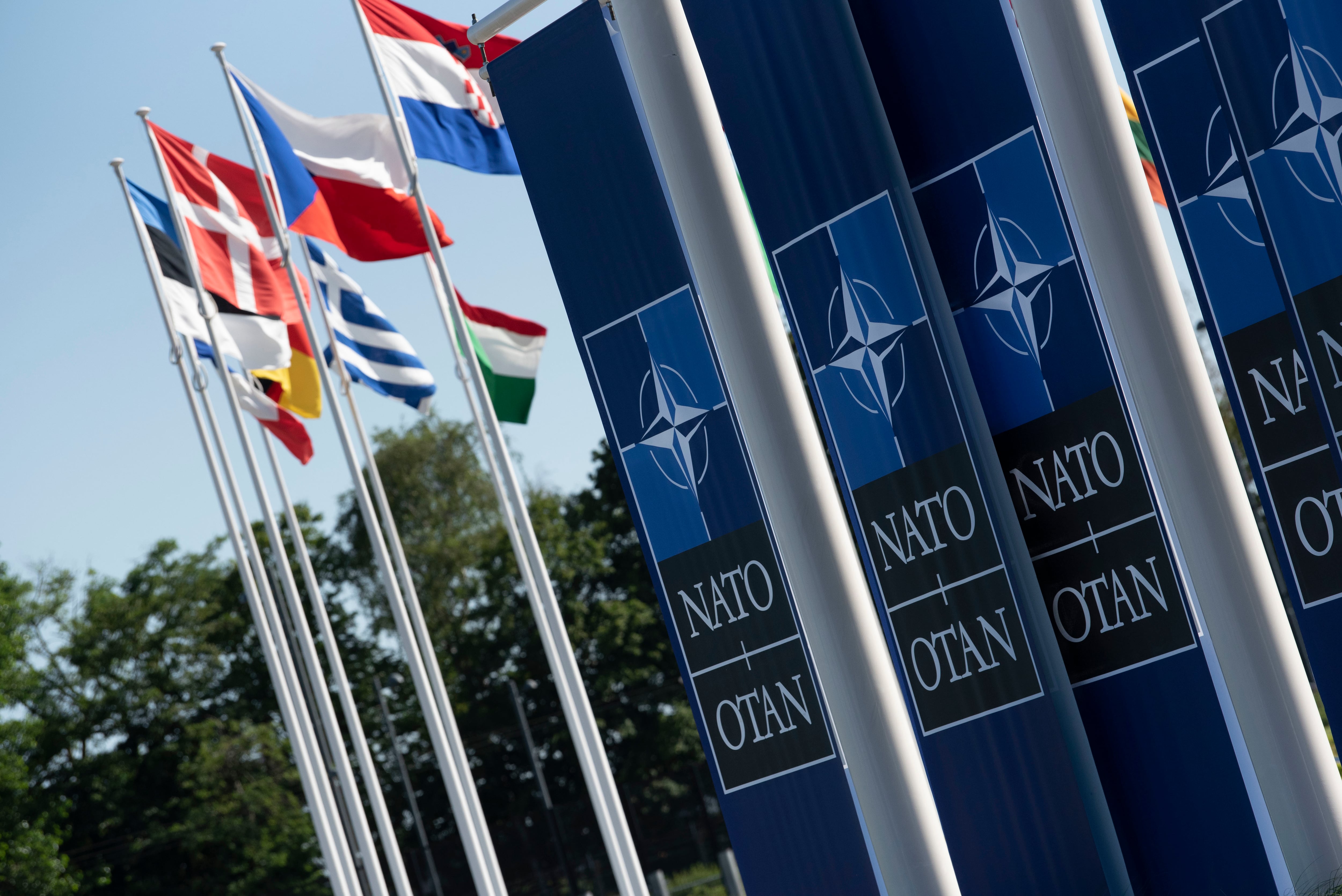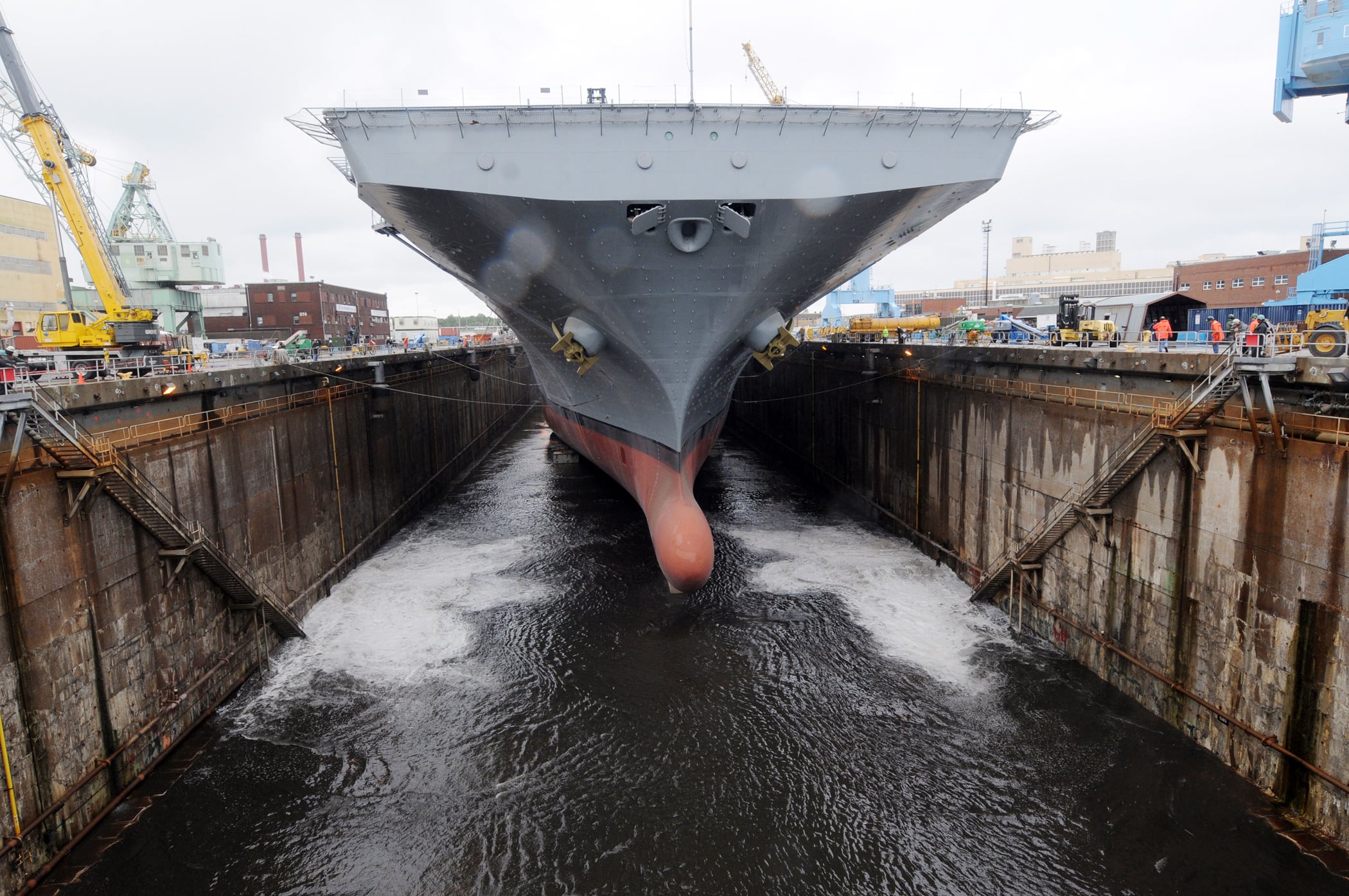BATH, Maine – The ship is plainly visible from Front Street, across the Route 1 bridge in downtown Bath. Nothing like this angular, almost hulking giant has ever been seen here, even after well over a century of shipbuilding at Bath Iron Works.
The futuristic shape of the Zumwalt, DDG 1000, has become familiar after more than a decade of graphics presentations and artist drawings, and models of the destroyer have been a staple at naval expositions for years. But now the whole ship is coming together, all construction blocks assembled and set afloat. People walk her decks and she rises and falls with the tide as all that planning turns into a real thing. She'll take to the sea for the first time in the spring.
The epitome of naval stealth design, Zumwalt's sleek shapes belie a ship filled with new features. Walking aboard, one of the first impressions is one of size — she is by far the largest ship ever called a "destroyer." So, one would think, she must be roomy inside.
"You know, she is almost 16,000 tons, 610 feet long, about 81 feet abeam, you imagine that everything must be spacious," said Capt. James Kirk, Zumwalt's prospective commanding officer. "But when you get on her, you realize she is packed full of the equipment necessary to operate her and give her the capability to fight."
Below decks, a main deck passageway is large and wide, designed to quickly and easily move supplies and ammunition to storage rooms below. But the forward hull is also taken up with the automatic reload equipment and shell magazines for the ship's two 155mm advanced gun systems — the biggest guns built into a naval ship since World War II.
The guns own the centerline real estate that, on other missile ships, is taken up by vertical launch systems. On Zumwalt, missile cells flank the guns, lining the sides of the hull fore and aft in a peripheral arrangement. Between the guns and the missile, that pretty much takes up the forward hull.
Amidships, the knife-like bow turns into a full, wide hull, crammed with power equipment. Zumwalt is an electric ship, with 78.5 megawatts of installed power — an unheard-of feature in a destroyer. Power units are arranged throughout the ship, reminding everyone of the different nature of its integrated power system, able to shift power from propulsion to sensors to weapons.
The bridge sits low on the superstructure on the O2 level, and will be staffed by a minimum of three watchstanders. During a visit this summer, shipbuilders were busy installing the windows, specially designed to withstand the green water expected to come as the narrow bow slices through, rather than rides, over waves.
Behind the bridge, the ship mission center is taking shape, but scaffolding rose through the space's two levels. More crew members will be assigned here than any other place, some working in a mezzanine area on the O3 level.
As expected, the machinery spaces are big — but surprisingly crowded. The power plant features two large MT-30 main turbine generators, two MT-5 auxiliary turbine generators and two advanced induction motors to generate all that electrical power.
Aft, a large boat bay sits under the flight deck, able to stow two 11-meter rigid-hull inflatable boats on a ramp with a third parked in the overhead. Doors in the transom open to extend the ramp to launch and recover boats at ship speeds of up to 13 knots.
Throughout, Zumwalt features systems that open or retract or lift or lower, many of them classified or restricted. A towed array system and towed torpedo countermeasures system will be installed aft. Side doors to handle underway replenishment will open to extend handling gear, special radars will rise on retractable masts.
Except for the flight deck, sailors will rarely appear topside when the ship is underway. Foredeck lifelines will be retracted when the ship is at sea. Embarkation and mooring stations are hidden behind doors in the hull.
One concession to conventionality has been to install a small mast at the forward end of the superstructure to carry the national ensign, a change made more convenient when a small conical structure carrying sensors was deleted.
While Zumwalt certainly looks like no other destroyer, Kirk insists she'll be able to mix easily with the fleet.
"From a lot of different aspects, she is a multimission destroyer capable of doing the same kinds of missions that the cruisers and the Arleigh Burkes [destroyers] can do," he said.
"What makes her unique is the power she generates, the survivability that is inherent within lots of her features, and then that gun. That is a unique aspect for this ship."
The guns, however, while not designed to shoot at moving targets, will give the three ships of the Zumwalt class an entirely new capability, Kirk insisted.
"When you are carrying hundreds of rounds, your ability to influence what is going on is significantly greater," he explained. "If you are carrying so many Tomahawk missiles and 600 rounds of long-range land-attack projectiles, you have a significant advantage. I think that is pretty unique."
One area in which the ship will not be as capable is in its ability to provide area air defense, covering other ships over a wide area.
"It is limited," Kirk acknowledged. "It is not the same air defense as the cruiser. But it is still quite capable." All indications, he said, show "that her ability to do air defense is going to be pretty capable but not with the same sort of ranges because of the deletion of volume search radar. You just do not have the same capability as on a destroyer or a cruiser with the Aegis SPY-1 radar."
The ship's flight deck is considerably larger than Burke-class destroyers.
"She has got a flight deck almost two times the size of a Burke's," Kirk noted. That, along with carrying a special operating force, "is pretty significant. You take it altogether. If I had a military problem that needed to be solved, there are definitely missions this ship can do that other ships would not be as well-suited to do."
One big question to be answered when the ship goes to sea will be how its unusual tumblehome hull — in which the hull narrows above the waterline — handles in the open ocean.
"This hull form is going to have different stability characteristics about its maneuvering that we are going to have to be very conscious of," Kirk said. "And I am confident, from what I see, that we are going to have the guidance and technical information we need to have in order to fly her, in order to maneuver her properly given the weather that is around us."
The Zumwalts will have maneuvering limitations just like any ship, he said.
"If you have a certain wave action with certain speeds, you can have a dynamic stability that becomes compromised," he explained. "Then you need to make sure you are using the proper amount of turn and speed to limit risks to the dynamic stability of the ship. And I am comfortable with what I see that we know how to operate the ship in whatever seas we face."
Design changes
At Naval Sea Systems Command in Washington, DDG 1000 Program Manager Capt. James Downey oversees the engineering team that handles all technical matters with the ships. He ticked off several key design or concept changes that have taken place.
"In 2010, we took out the volume search radar, the S-band sensor in the dual-band radar system, leaving the SPY-3 X-band radar, which received modifications from Raytheon to increase its volume-search capabilities. The system, installed for testing at Wallops Island, Virginia, will be tested next year on the self-defense test ship Paul F. Foster, which already has conducted a series of SPY-3 tests," Downey said. Those earlier tests, he said, "went really well."
A series of other changes enabled designers to take out about 50 tons from the deckhouse, Downey added, allowing the shift from composite construction to steel in the third ship of the class, the Lyndon B. Johnson. The second ship is named the Michael Monsoor.
Part of that weight reduction came from a change in the ship's secondary gun system, used for close-in defense. Originally, the Mark 110 57mm gun was specified for the ship — the same weapon used as the primary gun system in littoral combat ships and Coast Guard national security cutters.
But Downey also saw the Mark 46 30mm gun, in use aboard San Antonio-class amphibious ships, as a contender for DDG 1000. The smaller gun, he said, "was half the weight, half the cost, and had more offensive combat capability" than the 57mm. "I asked the team to go back and relook at the gun issue."
The analysis, he said, showed that the capability of the 57mm "was overstated in the model," while the 30mm was understated. "They saw a system that did not meet the requirement anymore and one that did."
A bonus, he pointed out, was a reduction of 24 tons by using the 30mm guns.
The size of the crew continues to be discussed. The ship is fitted with 186 racks, or berths, but the official crew size is 130, with another 28 people in the aviation detachment. Experience with other first-of-class deliveries, Downey said, could lead to a larger crew. The program already has laid out a crew organization with 17 additional crew members, for a crew total of 147, or 175 with the aviation detachment.
The added crew members, Downey said, would come in engineering ratings, gunnery, information systems technology, network and communications areas. A decision, he added, would need to be made in time to be included in the fiscal 2016 budget request.
Other racks have been provided for command and special operations teams. Originally, no flag — or command — facilities were to have been provided, but quarters for a destroyer squadron commodore and a small staff of six officers has been provided. A space able to accommodate 14 special operations team members and their gear is another feature of the ships.
The Zumwalts also were to have been led by an officer at the rank of commander, in line with all other destroyers. That has now changed, and a higher-ranking captain will drive the Zumwalts, on par with cruiser commands.
The ships, Downey explained, are a "pretty significant asset, with pretty complex capability, a very high level of training needed for the crew and officers and enlisted," requiring a more senior officer to lead.
A decision on whether the 1000s would be a "fleet up" command, where the executive officer is expected to succeed the commanding officer, could also become a consideration. "With the complexity of the ship, that is something I would say should certainly be considered," Downey said. "Nothing formal has been decided there, but that is, I think, a very real possibility."
The DDG 1000 program is phenomenally expensive — by the time the three ships are delivered, the Navy will have spent about $22 billion on research and development (R&D), procurement and construction, funded over more than 20 years. Planners early on envisioned 28 ships, then seven, then two and finally three — all from the same R&D pool. The Navy claimed the Zumwalts would cost an average of $3.3 billion each, but numerous critics warned they could hit $5 billion apiece or more.
So far at least, those predictions are not coming true, with costs for Zumwalt, Downey said, "around $3.4 billion."
For the entire program, "I am 3 percent below the [cost] objective," Downey claimed. "The objective is the low baseline number and the threshold is at the higher end."
Sometime in the spring, Bath expects to take Zumwalt to sea for the first time, beginning a series of engineering and systems trials that would last through the summer, and the Navy hopes to receive Zumwalt before the end of 2015.
Even then, the ship won't be complete, with elements of the combat system and computing environment still requiring work. But the time is coming when the hulking ship across Front Street will head down the Kennebec River, and the world will begin to see an entirely different kind of warship.





